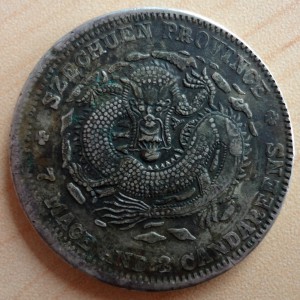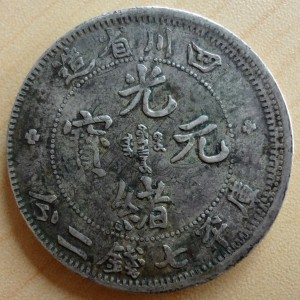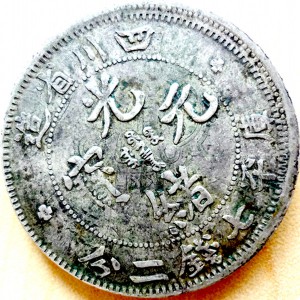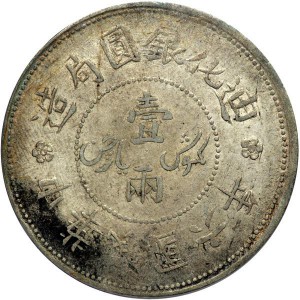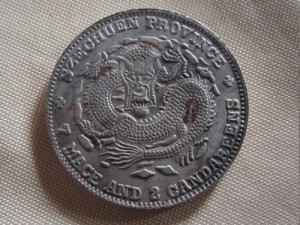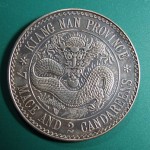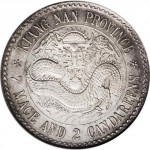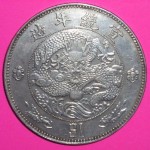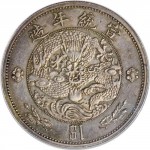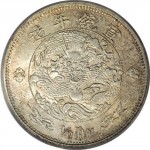Last month I wrote that chinese coins collectors ought to be especially careful in hunting fantasy dollars. Counterfeiters are well aware of the growing interest in these very special coins and have been increasingly daring and creative to profit from this trend.
This month I would like to show you a very interesting sample: a Szechuan dollar struck over a Sinkiang tael.
This unusual Chinese coin has been cleverly crafted to deceive advanced collectors. The design of this Szechuan dollar could reasonably be attributed to some unofficial or private mint, and details of the host coin are immediately noticeable underneath, particularly on the reverse.
This intriguing coin is obviously tempting for the warlord dollars collector. It is however a cheap forgery. The weight of this coin (35 grams) is consistent with its face value of one Xiāng Píng Tael (湘平壹两), and the worn out surfaces effectively conceal the abnormally soft details of the host coin. The shallow strike on the rims is still visible though and should immediately arouse suspicion. More generally, a 1917 coin of an higher denomination overstruck with a demonetized, lower face value coin type should also raise a few eyebrows.
The main problem with this coin though is that this particular Sichuan dollar design is a well-known fake Chinese coin type. From that point on, it is easy to guess that some enterprising counterfeiter decided that striking fake Xinjiang taels with an odd-looking Szechuan dollar would make them more interesting and less obvious to spot.
The first modern, machine-struck silver coinage in China began in Guangdong in 1889. The new currency gaining in popularity, other provinces started to issue silver dollar coins. The Jiang Nan province (江南) was an early adopter and issued its first complete set of silver coins in 1897. This early set was minted in low quantities, with an original design which was quickly replaced by a more common one during the next two years. That makes the 1897 Kiangnan silver dollar a valued addition to a chinese dragon dollars collection. Sadly, the popularity of this coin amongst collectors made it a choice target for counterfeiters.
I recently saw a new kind of fake Lao Kiangnan coin floating around on online auction websites. It can easily be spotted by the little bumps around the rosette at the left of the dragon, and inside its coiled tail, as seen below.
Aside of the bumps, the coin is well struck and much more convincing than the usual crude forgeries found on these kind of websites. For comparison, here is what a real Lao Kiangnan looks like:
Any bumps on a machine struck coin should immediately raise suspicion; they are usually artifacts appearing during the process of casting. In this case, the coin is visibly struck, but most likely using a cast die – the bumps are the imprint of tiny bubbles trapped between the mold and the metal during the casting.
In 1910, at the beginning of the short-lived rule of the 宣统 emperor (Xuan Tong), the Central Mint in Tianjin created new designs for general issues. Beautiful pattern coins were struck there in limited quantities, and most of them are rare and coveted nowadays.
One of such pattern coins is the 1910 imperial silver dollar (Kann 219). It features a menacing dragon flying over the sea, with a mountainous shore in the background. This design earned it the nicknames of 水龙 (shui long: water dragon), or more down-to-earth 宣二 (shorthand for 宣统二年, 2nd year of Xuan Tong) amongst chinese collectors. This beautiful coin is pretty hard to find, so I was quite happy when I found the specimen below:
Just looking at the picture, this coin looks nice. But simply comparing this coin to a picture of a genuine one, sold in a reputable auction house, one can easily see it is actually fake:
The genuine one has so much more relief and details, that the forgery completely pales out in comparison, contrary to the previous example of Yuan Shi Kai republican dollar. The poor reproduction of the nose of the dragon, its scales and the landscape is pretty damning…
It is interesting though to compare the fake dollar coin to a genuine half dollar of the same coins set (KM Y-23):
It turns out the fake One Dollar coin pattern is actually a decent copy of the simplified design from the smaller Half Dollar…
